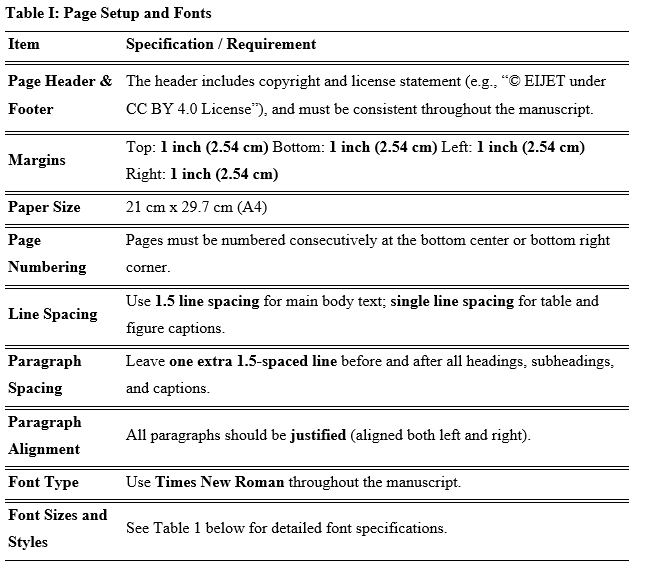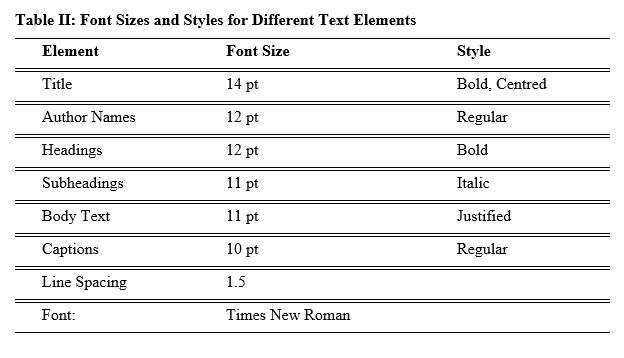Submissions
Submission Preparation Checklist
As part of the submission process, authors are required to check off their submission's compliance with all of the following items, and submissions may be returned to authors that do not adhere to these guidelines.- The manuscript has not been previously published in any form and is not currently under consideration for publication elsewhere.
- If the manuscript has been previously presented at a conference, a clear explanation has been provided in the "Comments to the Editor" section. If such information is hidden, then the editor has the right to reject the paper at any stage.
- The manuscript is submitted in the given format. The manuscript is formatted in Open Office, Microsoft or Google Docs, etc.
- The text is single-spaced using a 12-point font. Italics are used instead of underlining (except for URLs). All illustrations, figures, and tables are appropriately placed within the main text. DOI and URLs must be included for better accessibility of the reference.
Privacy Statement
EIJET Privacy Policy and Data Sharing Proclamation:
The EIJET Publishing values our relationship with authors and recognises the importance of respecting and protecting authors’ personal information and privacy. This policy (together with any other resources referred to in it) sets out the basis on which any personal information the author provides us (or data we collect about the author from other sources) will be processed (meaning collected, stored, and otherwise used) by us. The names and email addresses entered in this journal site will be used exclusively for the stated purposes of this journal and will not be made available for any other purpose or to any other party.
Please note that this policy may be further supplemented by terms included on other EIJET websites where the author might register. Please read this policy carefully as it sets out what the author can expect from us and gives our contact details if the author wishes to ask any questions or raise concerns about how we are processing your personal information.
At EIJET Publishing, we value your trust and are committed to protecting your personal information. This Privacy Policy outlines how we collect, use, and protect your personal data when you interact with our publications, websites, and services.
We may collect personal information from you in various ways, including:
- When you submit a manuscript: Name, email address, affiliation, and other contact details.
- When you register for email alerts or newsletters: Name and email address.
- Through website usage: Information collected automatically, such as your IP address and browsing behaviour.
We may use your personal information for the following purposes:
- Processing submissions: Managing manuscript submissions, communicating with authors, and facilitating the peer-review process.
- Providing access to content: Managing subscriptions and providing access to journal articles and other publications.
- Improving our services: Analysing website usage data to improve the user experience and functionality of our websites and services.
- Communicating with you: Sending you important updates, newsletters, and other relevant information.
Data Sharing and Disclosure
We will not share your personal information with third parties for any purposes other than those described in this Privacy Policy. We may share your information with:
- Peer reviewers: In the context of the peer-review process, we may share your manuscript with selected reviewers.
- Publishers: If your manuscript is accepted for publication, we may share your information with the publisher.
- Service providers: We may share your information with third-party service providers who assist us in operating our business, such as email system and website hosting service providers.
Data Security
We take appropriate security measures to protect your personal information from unauthorized access, use, or disclosure.
You have the right to:
- Access your personal information: Request access to the personal information we hold about you.
- Correct your personal information: Request corrections to any inaccurate or incomplete information.
- Object to processing: Object to the processing of your personal information in certain circumstances.
- Withdraw consent: Withdraw your consent to the processing of your personal information at any time.
Research Data Availability Statement
Authors are required to include a Research Data Availability Statement with their manuscript submission. This statement should clearly indicate whether the data supporting the findings of the research are publicly available, and if so, provide the repository name, link, and DOI (where applicable).
Authors should use one of the following formats, as appropriate:
1. Open Access Data:
“The data that support the findings of this study are available in [Repository Name] at [DOI or URL], under [license type, if applicable].”
2. Restricted Access Data:
“The data that support the findings of this study are available from [source], but restrictions apply to the availability of these data, which were used under license for the current study. Data are available from the authors upon reasonable request and with permission of [third party or organization].”
3. Non-Disclosure Statement:
“The data that support the findings of this study are not publicly available due to [confidentiality, ethical, security, or legal] restrictions. Further details can be obtained from the corresponding author upon reasonable request.”
Authors are encouraged to deposit their research data in recognized open access repositories (e.g., Zenodo, Dryad, institutional repositories, or discipline-specific databases) to promote transparency, reproducibility, and long-term accessibility of scholarly work.
Updates to this Policy
We reserve the right to update this Privacy Policy from time to time. You may access the policy updates by visiting our EIJET website.
Copyright and License Grant: EIJET retains copyright in all Articles or Papers published within the Journal (the "Works"). Except for any logos, emblems, trademarks, or other designated third-party materials (collectively, the "Excluded Materials"), EIJET grants a non-exclusive, worldwide license to reuse the Works under the terms of the Creative Commons Attribution 4.0 International License ("CC BY 4.0"). The full text of the CC BY 4.0 license is available at Creative Commons License.
Attribution Requirements: When reusing any portion of a “Work”, the author must attribute the authorship to the original author(s) and cite EIJET as the source of publication. The specific attribution format required by CC BY 4.0 can be found in the license itself on the Creative Commons Website.
Disclaimer: The Excluded Materials are not licensed under the CC BY 4.0 license, and all rights are reserved by their respective authors and owners. EIJET disclaims any warranty or guarantee regarding the accuracy, completeness, or reliability of the Works.
Contact Us
If you have any questions or concerns regarding this Privacy Policy or our data usage practices, please do not hesitate to contact us.
Office of the EIJET Journal,
Post Box 21, AMiT/AWTI Management Building, Office No. 8, Arba Minch University Main Campus, Arba Minch, Ethiopia
Tel: +251-910439239
E-mail: addisu.mulugeta@amu.edu.et, and eijet@amu.edu.et
Website: https://survey.amu.edu.et/ojs/index.php/EIJET/index



